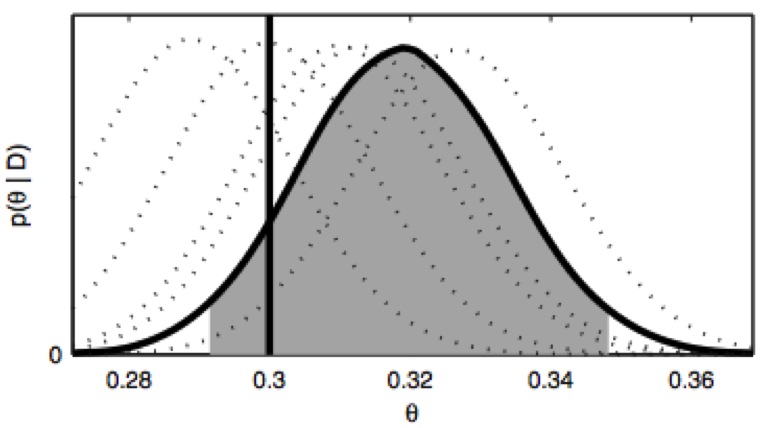SEARCH
ARTICLE TYPES
A robust approach to estimating rates from time-correlation functions
/John D. Chodera, Phillip J. Elms, William C. Swope, Jan-Hendrik Prinz, Susan Marqusee, Carlos Bustamante, Frank Noé, Vijay S. Pande
Preprint ahead of submission: [arXiv] [PDF] [SI]
The estimation of rates from experimental single-molecule data is fraught with peril. We describe some of the failures of existing methods and suggest a robust way to estimate rates from time-correlation functions.
Bayesian hidden Markov model analysis of single-molecule force spectroscopy: Characterizing kinetics under measurement uncertainty
/John D. Chodera, Phillip Elms, Frank Noé, Bettina Keller, Christian M. Kaiser, Aaron Ewall-Wice, Susan Marqusee, Carlos Bustamante, and Nina Singhal Hinrichs.
preprint: [arXiv]
We describe the general theory and implementation for a Bayesian extension of hidden Markov models applicable to the characterization of how measurement uncertainty and finite statistics can impact the confidence in rate constants and conformational state properties.
Dynamical reweighting: Improved estimates for dynamical properties from simulations at multiple temperatures
/John D. Chodera, William C. Swope, Frank Noé, Jan-Hendrik Prinz, Michael R. Shirts, and Vijay S. Pande.
J. Chem. Phys. 134:244107, 2011. [DOI] [PDF]
We describe how reweighing techniques can provide optimal estimates of temperature-dependent dynamical properties from simulations conducted at multiple temperatures.
Markov models of molecular kinetics: Generation and validation
/Jan-Hendrik Prinz, Hao Wu, Marco Sarich, Bettina Keller, Martin Fischbach, Martin Held, John D. Chodera, Christof Schüttle, and Frank Noé.
J. Chem. Phys. 134:174105, 2011. [DOI] [PDF]
A review of current best practices for the generation and validation of Markov state models for describing the stochastic dynamics of biomolecular systems.
Dynamical fingerprints: A theoretical framework for understanding biomolecular processes by combination of simulation and kinetic experiments
/Frank Noé, Sören Doose, Isabella Daidone, Marc Löllmann, Markus Sauer, John D. Chodera, and Jeremy C. Smith.
Proc. Natl. Acad. Sci. USA 108:4822, 2011. [DOI] [PDF]
We present a new framework for comparing essential features of the dynamics between experiment and simulation to identify the kinetics processes contributing to individual relaxation timescales in perturbation-response or correlation spectroscopy experiments.
Estimating equilibrium ensemble averages using multiple time slices from driven nonequilibrium processes
/Estimating equilibrium ensemble averages using multiple time slices from driven nonequilibrium processes: Theory and application to free energies, moments, and thermodynamic length in single-molecule pulling experiments
David D. L. Minh and John D. Chodera
J. Chem. Phys. 134:024111, 2011. [DOI] [PDF]
We derive a new estimator for estimating equilibrium expectations from nonequilibrium experiments, and show how it can be used to estimate a variety of useful quantities in simulated single-molecule force spectroscopy experiments.
The mechanical properties of PCNA: Implications for the loading and function of a DNA sliding clamp
/Joshua L. Adelman, John D. Chodera, I. W. Kuo, Thomas F. Miller III, and Daniel Barsky.
Biophys. J. 98:3062, 2010. Featured on issue cover. [DOI] [PDF]
Molecular simulations of the PCNA clamp responsible for DNA polymerase processivity show a surprisingly small energetic penalty for the deformation required for clamp loading.
Current status of the AMOEBA polarizable force field
/Jay W. Ponder, Chuanjie Wu, Pengyu Ren, Vijay S. Pande, John D. Chodera, David L. Mobley, Michael J. Schnieders, Imran Haque, David S. Lambrecht, Robert A. DiStasio Jr., Martin Head-Gordon, Gary N. I. Clark, Margaret E. Johnson, and Teresa Head-Gordon.
J. Phys. Chem. B 114:2549, 2010. [DOI] [PDF]
A report on the status of the AMOEBA polarizable force field and its ability to reproduce a diverse set of physical chemical phenomenon to high accuracy.
Optimal estimators and asymptotic variances for nonequilibrium path-ensemble averages
/David D. D. L. Minh and John D. Chodera.
J. Chem. Phys. 131:134110, 2009. [DOI] [PDF]
We derive an optimal estimator and corresponding statistical uncertainties for inferring expectations of bidirectional nonequilibrium processes. These estimators have widespread applicability in single-molecule biophysical force-spectroscopy experiments and nonequilibrium molecular simulations.
Bayesian comparison of Markov models of molecular dynamics with detailed balance constraint
/Sergio Bacallado, John D. Chodera, and Vijay S. Pande.
J. Chem. Phys. 131:045106, 2009. [DOI] [PDF]
A Bayesian scheme for comparing state space decompositions for Markov state models of biomolecular dynamics that incorporates the fact that physical systems must obey detailed balance. This paper utilizes recent results from Markov chain theory on edge-reinforced random walks.
Statistically optimal analysis of samples from multiple equilibrium states
/Michael R. Shirts and John D. Chodera.
J. Chem. Phys. 129:124105, 2008. [DOI] [PDF]
We present a highly general, statistically optimal approach for producing estimates of free energies and equilibrium expectations from multiple simulations that provably extracts all useful information from the data.
Keywords: Multistate Bennett acceptance ratio; MBAR; Bennett acceptance ratio; BAR; molecular dynamics; Monte Carlo; replica exchange
Technical Report: Self-consistent definition and computation of the electrostatic field for the Amber and related forcefields with particle-mesh Ewald
/John D. Chodera. Technical report. [PDF]
This technical report provides information on the computation of the electric field and its gradient for the Amber forcefield in particle-mesh Ewald (PME) in AMBER 10.
Predicting small-molecule solvation free energies: A blind challenge test for computational chemistry
/Anthony Nicholls, David L. Mobley, J. Peter Guthrie, John D. Chodera, and Vijay S. Pande.
J. Med. Chem. 51:769, 2008. [DOI] [PDF]
A blind evaluation of the accuracy of alchemical free energy methods for computing gas-to-water transfer free energies (solvation free energies) of small molecules demonstrates that modern forcefields are likely sufficiently accurate to be useful in drug design.




















